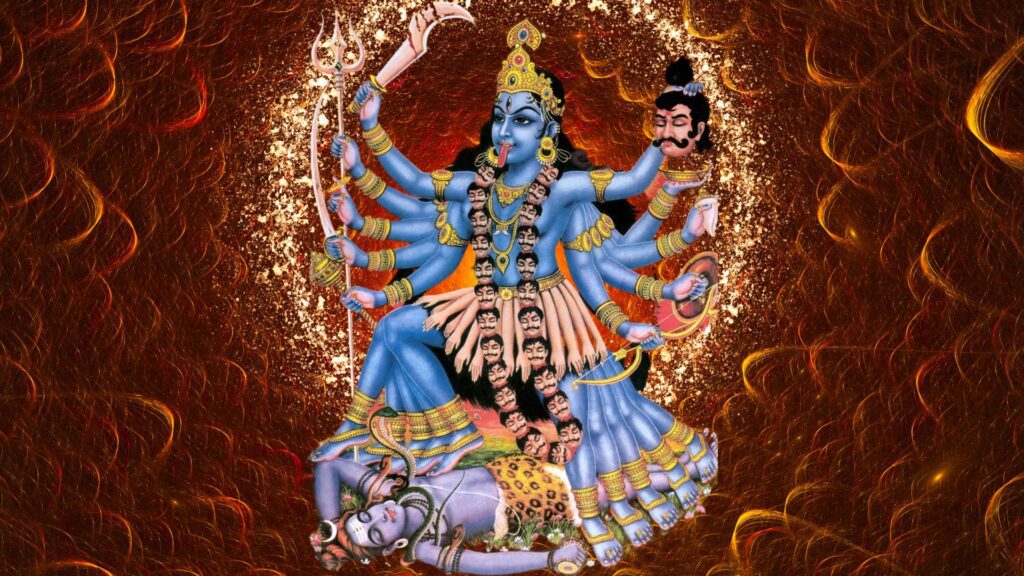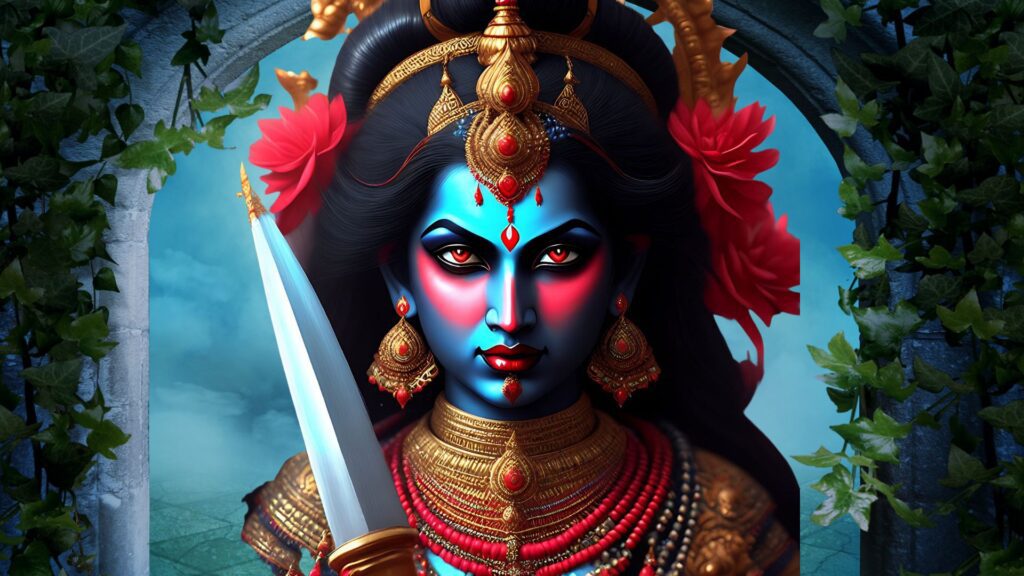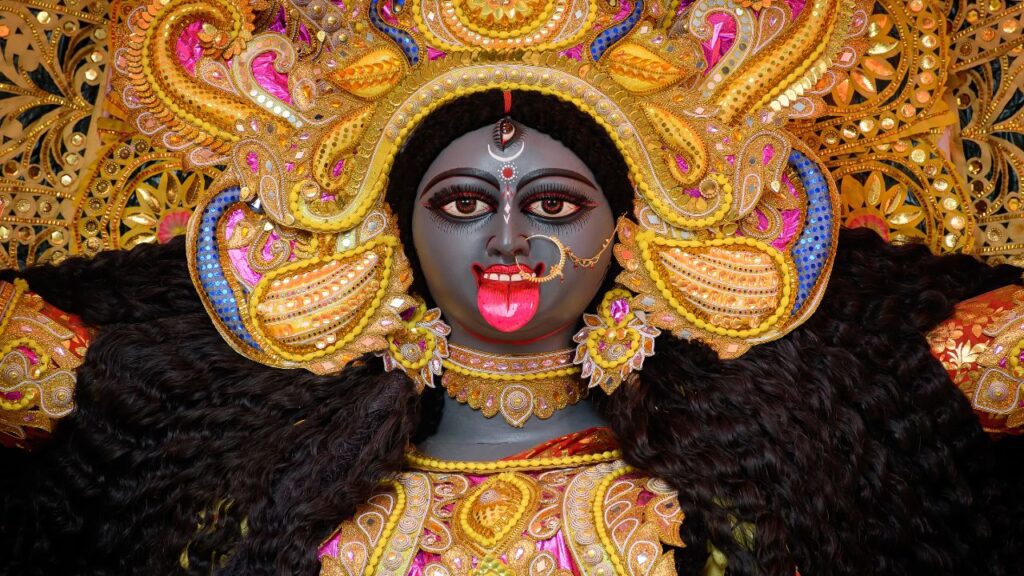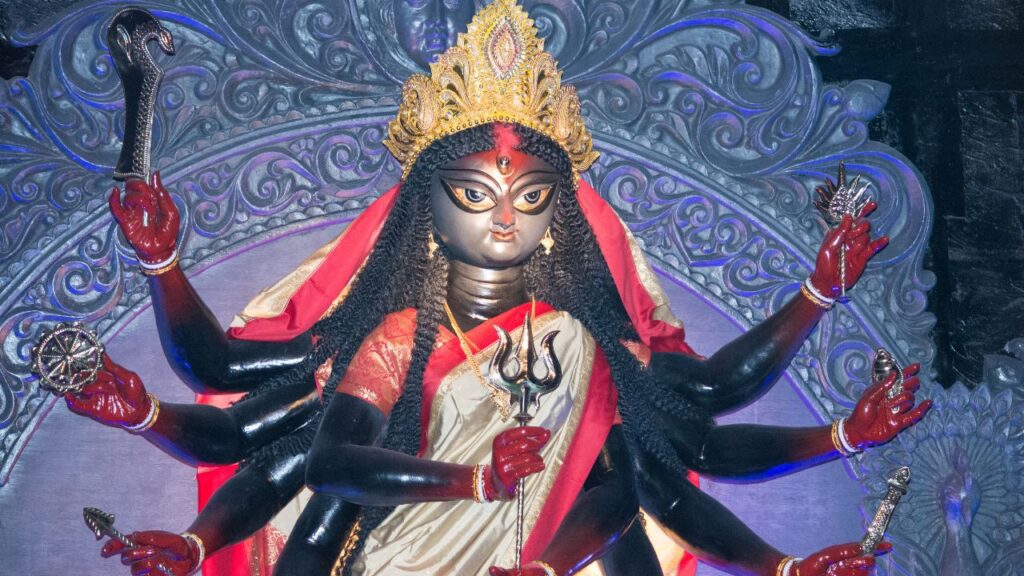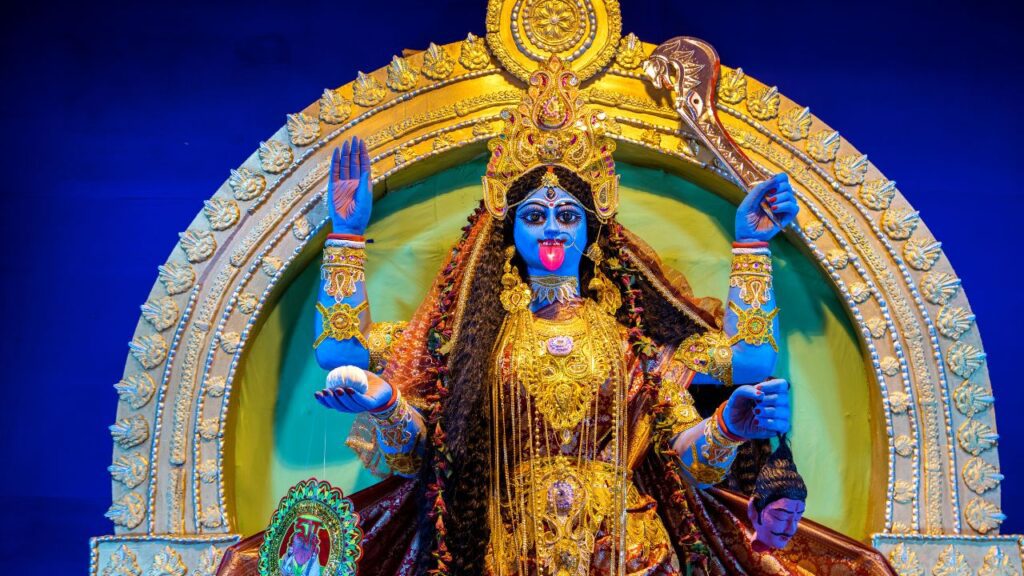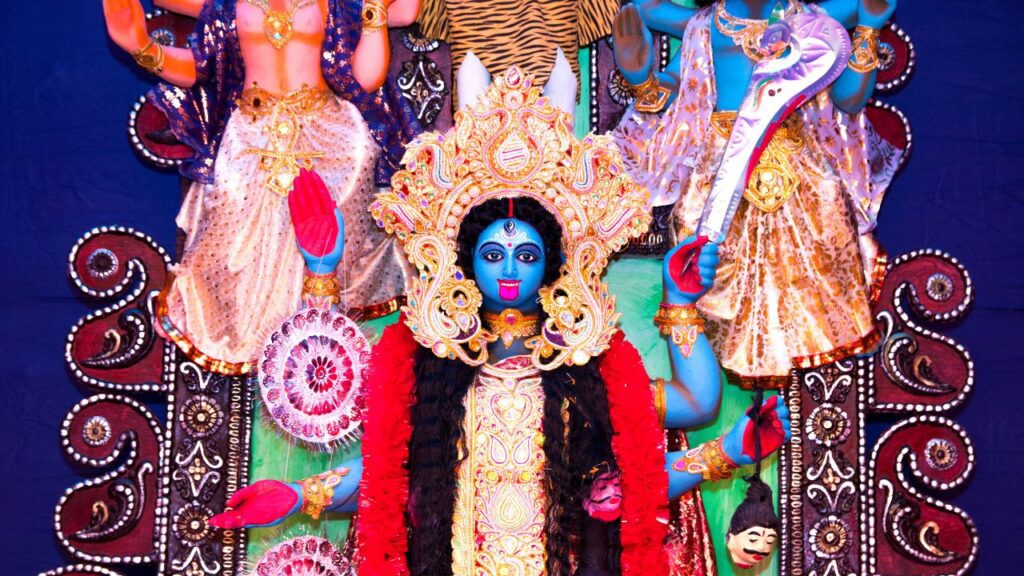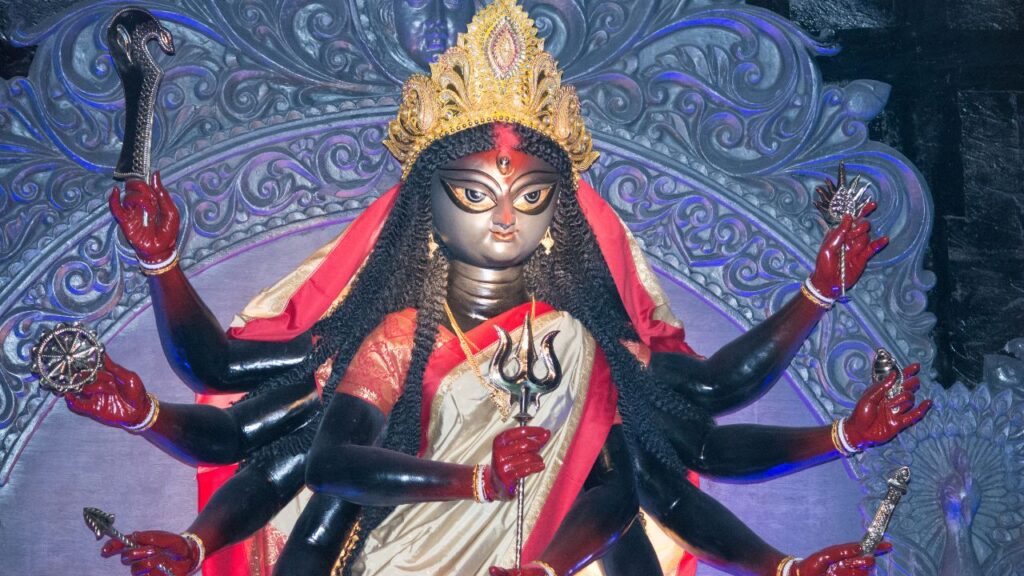Chakras : The Connection Between Kali and the Chakras
Introduction
Goddess Kali, the fierce and strong deity of Hinduism, has captivated both scholars and adherents of the faith. Her shocking appearance—dark skin, unkempt hair, garland of dead heads—has occasionally been misconstrued. But closer study of Kali’s symbolism and mythology reveals a complicated and varied goddess reflecting the cyclical aspect of life, death, and transformation.
Shiva’s and Kali’s Cosmic Dancing
The central Kali tale revolves on her complicated relationship with Lord Shiva, the foremost ascetic and destroyer-transformer in the Hindu pantheon. Often shown in a cosmic dance, Shiva’s calm and transformative power balances and limits Kali’s violent and destructive energy. Representing the yin and yang of the universe—that which is indivisible between the masculine and feminine cosmic powers—this celestial union

The Androgynous Shape
Some representations of Kali and Shiva show them as single, androgynous gods, Shiva on the right side and Kali on the left. This symbolic union of the two gods highlights their fundamental link in which the masculine and feminine ideals are inevitably linked to produce a harmonic whole. This artwork implies that birth and death, creation and destruction, are two sides of the same cosmic coin and that one may only acquire genuine balance and enlightenment by appreciating both aspects of the divine.
Tandava dance
Considered the Tandava, the cosmic dance of Kali and Shiva is a strong and dramatic depiction of the cycle of creation and death. Shiva’s silence in this dance balances and guides Kali’s intense and uncontrolled vitality. At its height, Shiva intervenes to stop Kali’s destructive dance and restore cosmic balance. Every ending provides the ground for a new beginning, hence this interaction of the two gods reflects the cyclical nature of life.
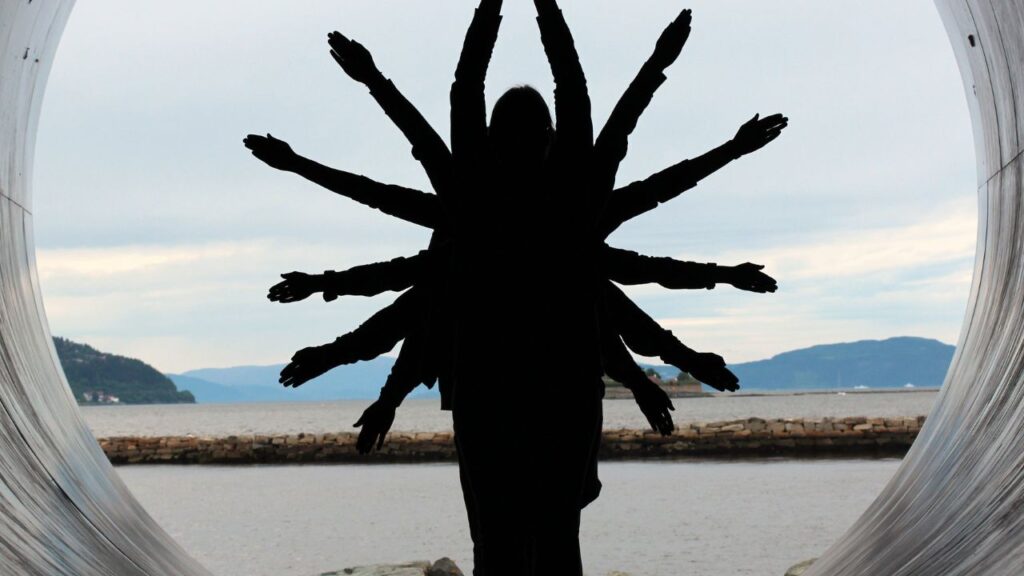
The symbolism in Kali’s Look
Every element of Kali’s appearance suggests a higher spiritual truth; she is full of symbolic value. Her dark complexion is frequently related to the primordial, unmanifest part of the divine, from which all creation emerges. Her tangled, disheveled hair captures both the inevitable march of death and the wild and turbulent spirit of time.
The Garland of Many Heads
Among Kali’s most distinctive features is the garland of cut heads hanging on her neck. This visual elaboration captures the collapse of the ego instead of focusing just on violent acts. The cut skulls symbolize our false identities discarding, our restricted perception of ourselves, and our devotion to the physical world. By dressed in this garland, Kali helps us to realize that true knowledge only comes from beyond the ego and embraces the endless character of the divine.
The sword and severe head
Kali’s sword, held with one hand, represents her capacity to cut through the veil of illusion and sever the links of ignorance. With her other hand, which represents the triumph of the higher self over the lower self—that of knowledge over illusion—she holds a severed head. This image implies that rather than merely a force of annihilation, Kali’s destructive power is a transformative energy that helps the old die and the new to arise.
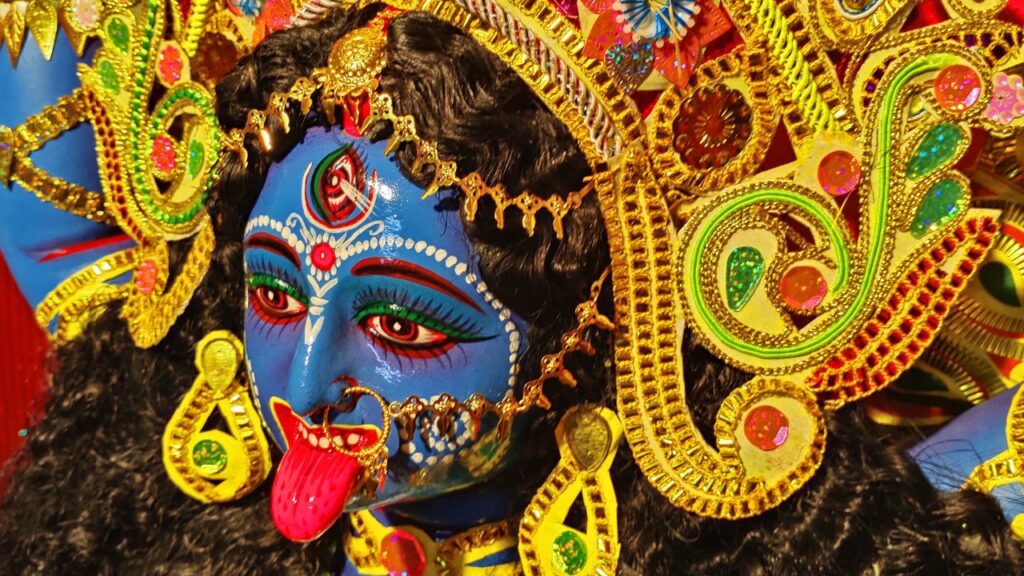
Kali as the Time Personification
The Sanskrit name “Kali” literally means “time,” and this temporal element greatly helps to define the goddess. Kali stands for the power guiding the never-ending cycle of creation, preservation, and destruction—that constant march of time. She is the great mother; the tomb claiming all mortal creatures originates from her womb, from which all life emanates.
Time’s Destroying Character
Kali’s dreadful and consuming power reflects the goal and ruthless nature of time. Time spares none, hence Kali is the perfect equaliser; she eats everything in her path without difference. This side of the goddess reminds us quite strongly of the fleeting nature of existence and the pointlessness of attempting to fix on the physical world.
The power of time to transform
But Kali’s devastating power serves as a trigger for transformation just as much as a tool of destruction. Kali creates the road for fresh development and rebirth by way of her devastating dance. She is the great liberator, separating us from the chains of ego and attachment thereby allowing us to accept the endless, formless core of the divine and transcend the limits of the physical world.
Kali’s Mantras
Retreading Goddess One of the most effective tools Kali uses to relate to her vitality is her mantra. The Kali mantra is a forceful cry to the vibrating deep currents of the universe, therefore guiding the changing power of the goddess.
The Significance Syllabic
The Kali mantra’s every syllable carries energetic charge and symbolic meaning. Starting with the holy syllable “Om,” which stands for the full ultimate truth, the mantra “Aim,” “Hrim,” and “Klim,” the next syllables, respectively, match, the forces of knowledge, purification, and change. The term “Camundayai” is a special epithet of Kali; the last syllable, “Svaha,” is a forceful incantation sealing the mantra.
The transformational power of repeating mantras
When recited consciously and with determination, the Kali mantra can unlock enormous spiritual insights and motivate great personal transformation. The repetition of the mantra helps the mind to settle so that the practitioner may approach the primal, cosmic powers linked with Kali. By means of this practice, one can start to remove the layers of ego and attachment, therefore opening the road for a stronger contact with the divine and improved knowledge of the cyclical character of existence.
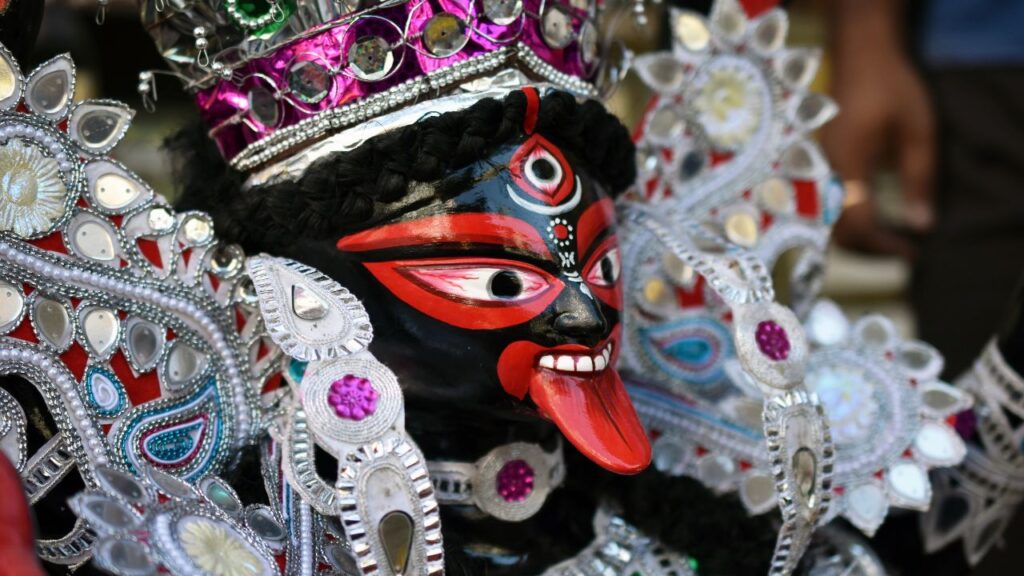
The many nature of Kali
With her fierce and destructive tendencies front and centre, Kali’s image is sometimes one-dimensional. Under closer inspection, though, this enigmatic goddess reveals her numerous sides. As much as a deity of death and annihilation, Kali is a tremendous force of creation, transformation, and freedom.
Kali’s Element of Nurturing
Benevolent on her horrific façade, Kali also is the great mother—the life force. She is the womb from whence all life begins; her consuming nature captures the cyclical nature of the universe. Like a mother protects and feeds her children, Kali is the ultimate guardian fiercely defending her followers from harm and guiding them on the road to enlightenment.
Kali’s Liberative Authority
As much as a force of annihilation, Kali’s destructive energy provides relief. By dissolving the ego and severing the ties of attachment, Kali liberate the person from the limitations of the material world and welcomes the boundless character of the divine therefore transcending the limits of the physical world. The practitioner can remove the false identities and limiting concepts that have long impeded her by means of her grace, therefore paving the road for a great and profound spiritual awakening.
Significance of Kali in Hindu Mythology
Kali’s role in Hindu mythology is complicated and somewhat significant since she stands for the fundamental concepts directing the universe. Her presence penetrates the holy writings and stories, working as a strong archetype stressing the basic truths of the human experience.
Kali according to the Vedas and Puranas
The ancient Hindu writings—the Vedas and Puranas—offer significant insight on Kali’s nature and her relationship with the almighty. These holy writings explore the complicated interactions between the violent and destructive goddess Kali and Shiva, the ultimate ascetic and cosmic changer. These stories help us to better understand the cyclical nature of creation and destruction as well as the basic role Kali performs in this cosmic dance.
Shakti’s embodiment is Kali.
Hindu religion links Kali occasionally with the divine feminine principle Shakti, which stands for the dynamic, creative power of the universe. As Shakti is her embodied form, Kali is the source of all power and the engine driving the expression of the physical universe. Her fierce and untamed nature symbolizes the raw, primitive energy guiding the entire cosmos, therefore reminding us of the natural strength and potential everyone has.
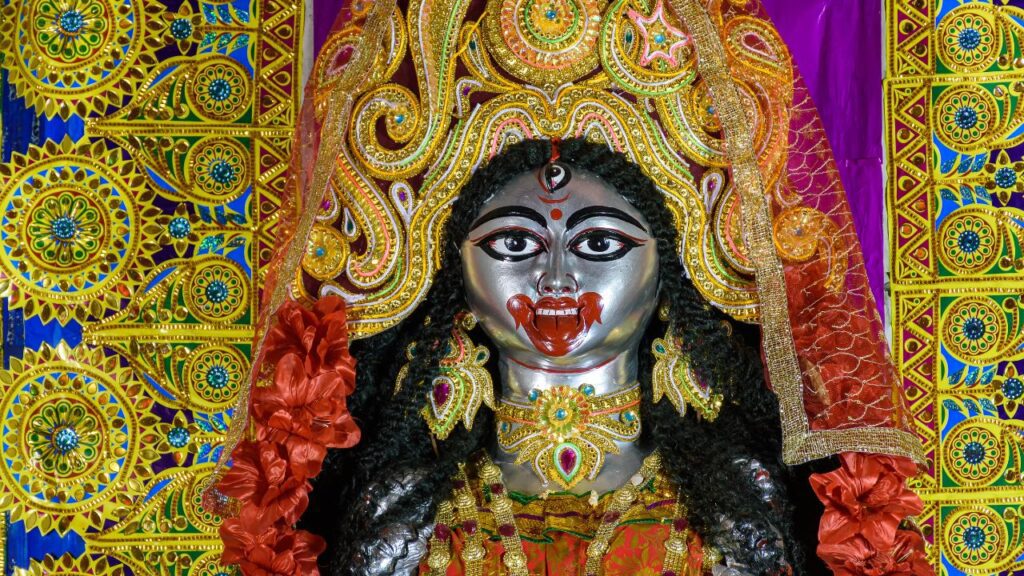
The Relevance of Kali in the Contemporary World
The figure of Kali reminds us of the natural anarchy and unpredictability spun into the fabric of existence in a culture sometimes preferring order, control, and predictability. Her presence on the modern spiritual landscape reminds us powerfully of the need of realizing the cyclical character of life, facing our concerns and limitations, and letting go to let the changing power of the divine.
Kali as an Empowerment Symbolic Agent
Especially for women and those who have been ostracized or mistreated, Kali has transformed for many followers into a symbol of empowerment. Her clear and unrestrained attitude signals a rejection of patriarchal rules and a reclamation of the divine feminine. By means of Kali’s spirit, people can reach their own inner force, courage, and endurance, thereby leading and motivating them against adversity.
Kali’s Thoughts on Impermanence
The lessons of Kali offer a strong cure for the uncertainty and anxiety that usually accompany modern life at a period of continuous transformation. Her emphasis on the cyclical character of creation and destruction and the impermanence of existence reminds us that nothing in this world is permanent and that real tranquility and contentment only will be reached by transcending the attachments and illusions of the material world.
Conclusion
Evidence of the enormous depth and intricacy of Hindu mysticism is the enigmatic person of Goddess Kali. Kali catches the basic facts underlying the human experience by means of her dynamic connection with Lord Shiva, amazing physical beauty, and embodied temporality. Accepting the lessons and insights Kali offers will enable us to grow in knowledge of the cyclical nature of life, the need of balance and transformation, and the immense potential everyone of us has.
#chakra #kali #meditation #chakras #thirdeye

